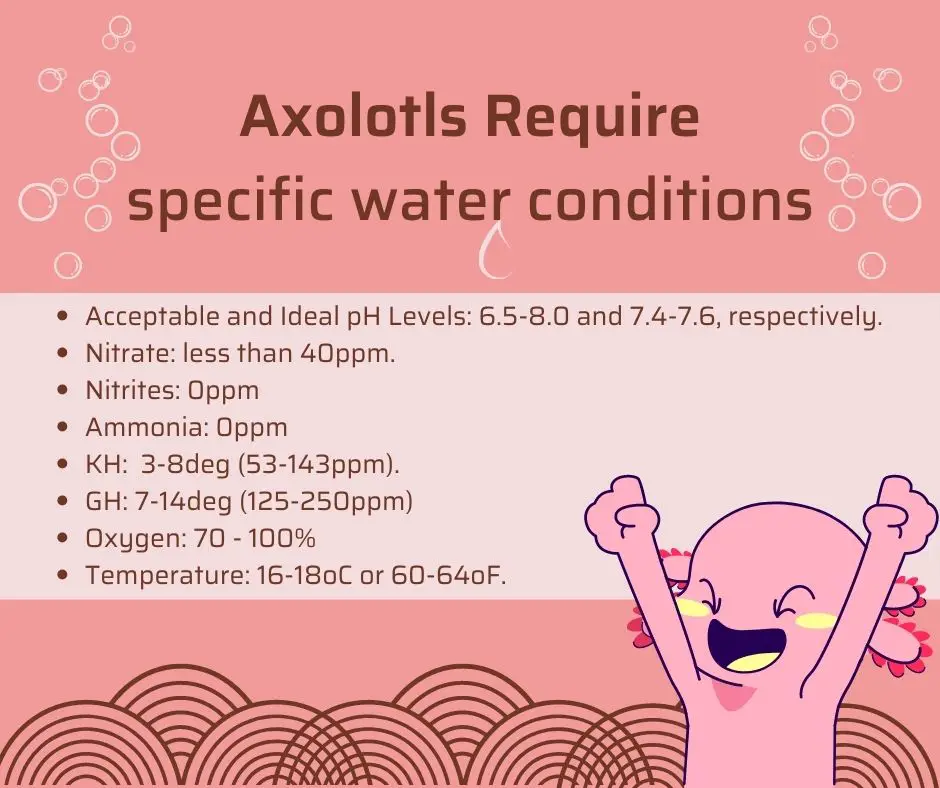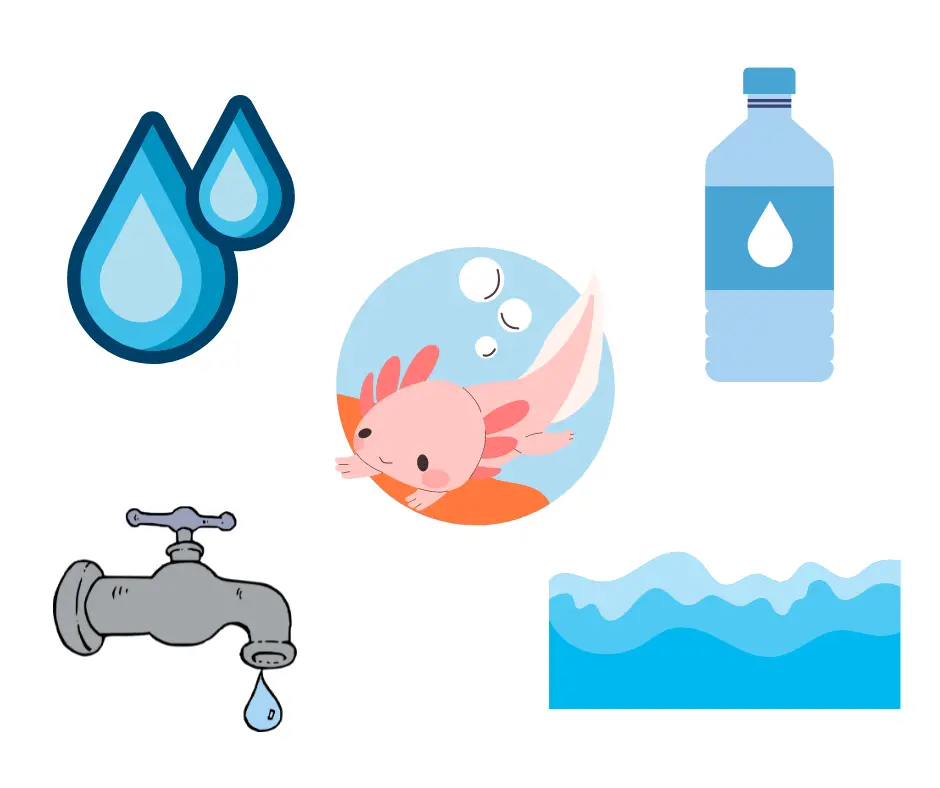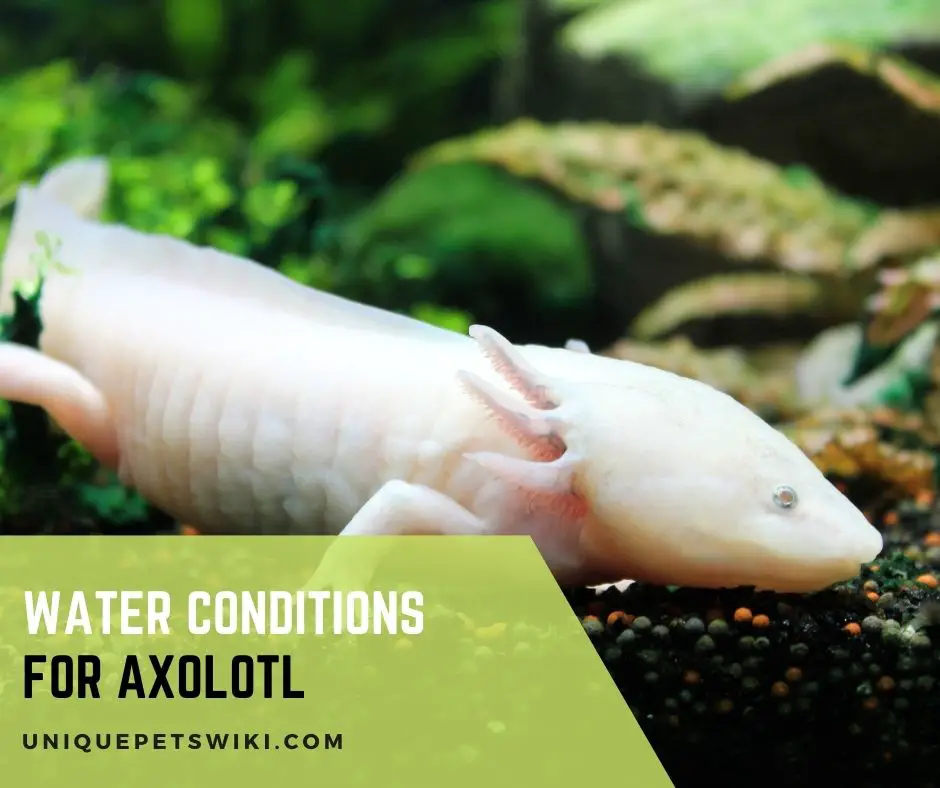Axolotls require specific water parameters to help keep them happy and healthy.
Axolotls are cold-water species and require a temperature around 60-64F or 16-18C. The ideal pH for an axolotl tank is around 7.4-7.6, and they prefer brackish water in their tank.
Axies are salamander species that spend their entire lives in water. Therefore, they rely on water quality for their biological processes like nutrition, respiration, excretion, etc.
As a new axolotl owner, you may wonder what other water conditions axolotls will need. This article has helped highlight everything you need to know about the ideal water parameter for axolotls.
Contents
What Water Conditions Do Axolotls Need?
Here is a breakdown of the ideal water conditions that axolotls need to keep them healthy.
- Acceptable and Ideal pH Levels: 6.5-8.0 and 7.4-7.6, respectively.
- Nitrate: less than 40ppm.
- Nitrites: 0ppm
- Ammonia: 0ppm
- KH: 3-8deg (53-143ppm).
- GH: 7-14deg (125-250ppm)
- Oxygen: 70 – 100%
- Temperature: 16-18oC or 60-64oF.

Cycling
It is very crucial that you cycle the axolotl tank to help bring out the beneficial bacteria in the tank before you even introduce your axolotls. The bacteria will help to convert the ammonia and nitrites in the water to nitrates.
Cycling of an axolotl tank is like that of any other fish. Cycling an axolotl tank is quite easy and consumes less time. Some of the steps to follow when cycling an axolotl tank are stated below:
- Fill the tank with dechlorinated water.
- Set up the tank and install the filters.
- Add nitrifying bacteria to the tank to help start the cycling process.
- Add ammonia into the water to help feed the bacteria.
- Test the water parameters in the water with a test kit.
- Leave the water for about 10-14 days for the cycling process to complete
- Introduce your axolotl after the nitrogen cycle is complete.
- Test the water parameters weekly for the first 5-6 weeks and then twice a month afterward.
- Change around 20-30% water weekly.
Note: When using tap water for your axolotl’s tank, use an aquarium water conditioner to remove chlorine and chloramines from the water.
Type of Water Axolotls Need
It is important to know that the type of water you use for an axolotl tank can determine their overall health.
Although axolotls require brackish water in captivity, they are well adapted to freshwater. It is recommended that you house them in freshwater as a beginner axolotl keeper.
An axolotl will need at least 10 gallons of cold water to live comfortably. Here is a breakdown of some types of water you can use for an axolotl’s tank.

Bottled Water
Bottled water is usually treated spring water but has natural minerals and salts.
It is safe to use bottled water for your axolotls without altering it. They are rich in minerals found in axolotl’s natural environment like potassium chloride, sodium chloride, etc.
Tap Water
Although the contents of tap water vary from place to place, most tap waters are treated with chlorine and chloramines, making them unsuitable for axolotls.
First, you will need to allow tap water to sit for 24 hours or use a water conditioner to remove the chlorine and chloramines from the water. After that, you can then use it for your axolotl’s tank.
Well Water
It is possible to use well water for your axolotl’s tank. However, you will need to first test the water to see if it is the appropriate water parameter for your axolotls.
Some well water may have high iron content or inappropriate pH not suitable for axolotls. Furthermore, well water may not have enough oxygens for your axolotls need.
Distilled Water
It is recommended not to use distilled water for your pet, and this is because distilled water does not have important minerals and salts that your axolotls require. Furthermore, it has a higher percentage of hydrogen and acidic pH than tap and bottled water.
Axolotl Water pH Requirements
The suitable pH requirement for axolotls is around 7.4-7.6. However, axolotls can live in a wider pH range between 6.5-8.0.
There will be ammonia build-up if the pH in your axolotl’s tank goes above 8.0 and can even kill your pet. Therefore, it is important that you monitor the pH levels in their tank constantly and adjust once there is a small change.
You can measure the pH levels in your axolotl tank using the water test kit.
KH (Carbonate Hardness)
Carbonate hardness is the measurement of the water’s capacity to neutralize the acid.
Carbonate hardness (KH) is very important for stabilizing the pH in your axolotl’s water. Furthermore, it is an energy source for nitrifying bacteria in the tank.
The nitrifying bacteria use KH for photosynthesis when carbon dioxide is absent. You can use aquarium KH test kits to measure the total alkalinity in the water. The ideal KH level for axolotl’s tank is 3-8deg or 53-143ppm.
GH (General Hardness)
General hardness is used to describe the level of dissolved magnesium and calcium salts in water.
Axolotls usually prefer slightly hard water rich in substantial amounts of dissolved salts, and this helps to boost their gill function and has other health benefits.
However, the axolotl can develop temporary anemia if kept in soft water. The ideal GH for an axolotl’s tank is between 7-14deg or 125-250ppm.
Salinity Level
Axolotls prefer brackish water (a mixture of freshwater and saltwater) to stay healthy because they need slightly hard water to boost their gill function.
However, they can live in freshwater without any issues. You can keep your axolotls in freshwater as a beginner hobbyist and give them a little salt to get the benefits of living in brackish water.
Nitrate Level
Nitrate is important for axolotl’s tank as it helps create a healthy colony of bacteria that converts toxins like nitrites and ammonia from the tank. This is why you will need to do a water cycle before adding axolotl to a new tank.
Axolotls can stay in a tank with a low level of nitrates that is less than 40 ppm. You will see algae blooms in your axolotl’s tank if the nitrate levels get too high. This can be toxic to your axolotls.
You can ensure the nitrate level in your axolotl’s tank is optimal by carrying out regular tank maintenance and ensuring biological filtration.
However, a tank with zero nitrate level indicates no healthy bacteria in the tank for converting harmful chemicals. This then indicates that something is wrong in the aquarium that you should address immediately.
You can then perform a nitrogen cycle to help buildup the nitrate level in the tank. You can ensure the nitrate level is optimal by testing your axolotl tank for nitrate regularly.
Ammonia Level
The build-up of ammonia in an axolotl’s tank can be fatal to axolotl. Therefore, it is important to monitor the ammonia levels regularly. If the tap water used has chloramine, there can be ammonia build-up in your axolotl’s tank.
The buildup of ammonia can also occur from the waste produced by axolotls. A high pH level can also cause the buildup of ammonia. The ideal range of ammonia level in an axolotl’s tank should be 0ppm.
You can prevent ammonia buildup by only using tap water free from chlorine and chloramine. Furthermore, you should try and perform regular water changes to keep the ammonia level at bay.
You should also ensure the water temperature and pH in your axolotl’s tank are optimal to help prevent ammonia buildup.
Nitrites Level
Apart from ammonia, nitrites are also harmful to axolotls and should be tested regularly. However, they are less harmful than ammonia but should be prevented from building up in your axolotl’s tank.
A buildup of nitrites can occur when the nitrifying bacteria in the aquarium consumes the ammonia in the tank.
The ideal nitrites level in an axolotl tank should be 0 ppm. You can prevent the buildup of nitrites in the axolotl aquarium using the same method to prevent ammonia in the tank.
Axolotl Water Temperature Requirements
The water temperature is another crucial water parameter when caring for axolotls. Axolotls require cold water in their tank, and they are quite sensitive to temperature variations.
The ideal water temperature for axolotls is between 60-64oF or 16-18oC. However, they can tolerate water temperatures between 59-73oF or 15-23oC.
The increase in the water temperature can lead to loss of appetite, lack of movement, health problems, and other issues if not addressed quickly.
You can use an aquarium fan to lower the water temperature in your axolotl’s tank. However, you will need an aquarium chiller to cool their tank if you live in warmer climates.
Chlorine & Chloramines
Chlorine and chloramines are commonly found in tap water at a rate of 0.5-2.0mg/l, which can be quite harmful to axolotls. Chlorine and chloramines destroy the good bacteria in the aquarium and can also burn the axolotl.
Therefore, it is recommended to use 7.4mg/l of sodium thiosulphate to every 1 mg/l of chlorine to remove them from the water.
You can also remove chlorine from the water by allowing the water to sit for 24 hours for the chlorine to dissipate before adding it to your axolotl’s tank.
Oxygen
Oxygen is very important for any healthy aquarium. A healthy axolotl tank should be 70-100% saturated and contains 10mg/l at 15C. Excess oxygen saturation in the tank can lead to health problems like gas bubble disease.
However, axolotls can cope in tanks with lower oxygen by taking surface air into their lungs.
If you notice they are regularly going up for air, this means the oxygen levels are low. You can solve this issue by checking the filter in the tank or adding an air pump or bubbler to the tank.
Water Flow
In the wild, axolotls are used to stable water conditions. If kept in water with significant currents, your axolotls will get stressed and lose their appetite.
You can determine when axolotl is stressed due to water flow if they have forward-turned gills.
In captivity, the filter output is the main cause of strong water flow in an axolotl’s tank. Therefore, it is recommended to use spray bars and other flow-spreading outlets to reduce the water flow.
How to Check Axolotl Water Conditions
It is important to check the axolotls’ water conditions in a tank to help ensure the water parameter is at an optimal level. A great water test kit to check axolotl’s water condition is the API Freshwater Master Kit.
Many axolotl owners recommend this as it is very accurate and can test most water parameters. You can check the water conditions in your axolotl’s tank weekly and biweekly.
API Water Test Kit
- Contains one (1) API FRESHWATER MASTER TEST KIT 800-Test Freshwater Aquarium Water Master Test Kit, including 7 bottles of testing solutions, 1 color card and 4 glass tubes with cap
- Helps monitor water quality and prevent invisible water problems that can be harmful to fish and cause fish loss
- Accurately monitors 5 most vital water parameters levels in freshwater aquariums: pH, high range pH, ammonia, nitrite, nitrate
- Designed for use in freshwater aquariums only
- Use for weekly monitoring and when water or fish problems appear
Last update on 2022-12-30 / Affiliate links / Images from Amazon Product Advertising API
Tips for Maintaining Axolotl Water Tank
It is the responsibility of axolotl’s owners to give your axolotl the best care and maintain the water in their tank. Here are some ways that you can use to keep the water parameters and toxin levels at an optimal level.
Always Set The Nitrogen Cycle
It is crucial that you cycle your aquarium before you add any axolotls to the aquarium. Cycling the tank will help create a colony of beneficial bacteria to keep the toxins at bay.
Cycling of an aquarium will take a couple of weeks to complete and is a great way to maintain your axolotl tank.
Consider Adding An Aquarium Filter
Another great way to maintain axolotl’s tank is to invest in an aquarium filter. An aquarium filter will help to allow beneficial bacteria to form and remove harmful toxins like ammonia and nitrites from the tank.
Using an aquarium filter helps to reduce how frequently you will change the water in your axolotl’s tank. This is because they are quite messy, and you will need to perform daily water changes if you are not using an aquarium filter.
However, you should opt for a filter with a low water current to avoid stressing your axolotls.
Avoid Overfeeding And Clean Up The Waste Regularly
It is very dangerous to overfeed your axolotls. Overfeeding your axolotls can lead to constipation, increased waste production, and bad water quality.
You can maintain the water quality in an axolotl’s tank by removing waste regularly and avoiding overfeeding them.
Regular Water Changes
A good way to maintain the water in an axolotl’s tank is to change the water regularly.
You will need to do 20% water changes weekly and then siphon rotten plants and uneaten food. This will help to ensure that you can provide the ideal water parameters for your axolotls.
Always Monitor Water Parameters
An important way to maintain the water condition in an aquarium is to always monitor the water parameters. This will help to detect any change in the water parameters quickly and make necessary adjustments when needed.
Conclusion
Providing the right water parameter for axolotls can be quite hard if you are a beginner hobbyist.
However, caring for them is relatively easy if you can research and learn the ideal water conditions and factors you need to create an ideal home for them.
You will also need to maintain their tank regularly to help keep the water parameter stable and prevent the buildup of toxin levels in the aquarium.
We hope this article provides useful information on how you can create the best water conditions for your axolotls.
You can message us in the comment section below if you have any comments or questions about the ideal water condition for your axolotls.

